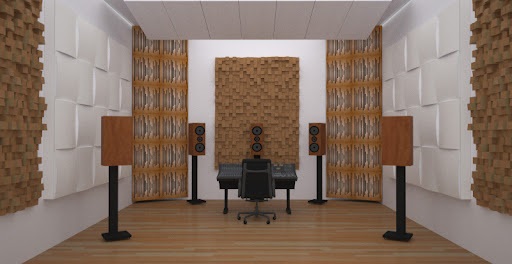Acoustic insulation is a material that works to reduce the noise that enters a room from outside the house or from other rooms. Acoustic panels absorb sound; their primary function is to reduce reverberation and echo in rooms.
The porosity gives the sound-absorbing function; they are soft and light materials to absorb well. To give you an idea of what great acoustic panels would be, mattresses, sofas, or cushions. That’s why many acoustic panels are wooden frames with a core of absorbent material and upholstery.
Usually, these panels come in sizes from about 60cm to 1m with different shapes and colors to adapt very well to the aesthetics of any room. They are usually 2 to 5 cm thick and can be either hung or glued directly to the ceiling.
Types of Acoustic Panels
Honeycomb decorative acoustic panel
One of the most popular because of its recognizable wavy shape. On the one hand, this type of panel has the advantage of being more discreet than the average because it does not occupy much volume towards the outside (it is relatively flat). But, on the other hand, this same characteristic usually gives it a lower acoustic absorption coefficient.
We understand that it is especially beneficial for home and local conditioning with little space and moderate ambient noise levels. With these characteristics and lightness, this panel can also be applied on ceilings, although there are other types of pieces more specific than this one.
Optimal for:
- Home and bedrooms
- Home studios
- Small rooms with low reverb
Pyramid-shaped acoustic panel
This is possibly the best-known acoustic absorber model. Its characteristic pyramid shape takes us back to ancient Egypt and the most sophisticated recording studio. It is often found on television sets, radio studios, or even in music venues to destroy the hated reverberation.
This type of foam offers a higher wave absorption rate thanks to its angular shape, and like the honeycomb, it eliminates noise similarly regardless of its origin. The height of its pyramids, in turn, influences its effectiveness, so it presents variable absorption quotients depending on the same.
While it is bulkier than the alveolar, it offers better noise dissipation, ideal for creating a space free of voice bounces or where microphones can receive unwanted feedback.
Optimal for:
- Home studio
- Voice and instrument recording rooms
- Venues with considerable reverb or live music
- Recommended Model
Saw model wall panel
This type of panel is the first one with the characteristic that, depending on the placement, we will observe changes in its sound absorption.
These sound-absorbing panels present a powerful elimination of frequencies when their flat sides face the emitting focus of the wave; therefore, they are extra effective when placed on the parallel walls farthest away from the emitter.
Independently of this characteristic, they also allow alternating the position of the acoustic tiles, achieving a more powerful and effective absorption from either side. This makes them very useful for environments with powerful sound fronts and high reverberation levels.
Optimal for:
- All recording studios
- Large rooms with localized sound fronts
- Eliminate most ambient noise
Acoustic insulation material can be installed during construction or later as part of a home improvement project. In such a case, blown-in products, such as foams, are easier to install in existing homes.

